Jaewon Lee
Jack
Efficient Speculative Decoding for Llama at Scale: Challenges and Solutions
Aug 11, 2025Abstract:Speculative decoding is a standard method for accelerating the inference speed of large language models. However, scaling it for production environments poses several engineering challenges, including efficiently implementing different operations (e.g., tree attention and multi-round speculative decoding) on GPU. In this paper, we detail the training and inference optimization techniques that we have implemented to enable EAGLE-based speculative decoding at a production scale for Llama models. With these changes, we achieve a new state-of-the-art inference latency for Llama models. For example, Llama4 Maverick decodes at a speed of about 4 ms per token (with a batch size of one) on 8 NVIDIA H100 GPUs, which is 10% faster than the previously best known method. Furthermore, for EAGLE-based speculative decoding, our optimizations enable us to achieve a speed-up for large batch sizes between 1.4x and 2.0x at production scale.
Self-supervised denoising of visual field data improves detection of glaucoma progression
Nov 19, 2024Abstract:Perimetric measurements provide insight into a patient's peripheral vision and day-to-day functioning and are the main outcome measure for identifying progression of visual damage from glaucoma. However, visual field data can be noisy, exhibiting high variance, especially with increasing damage. In this study, we demonstrate the utility of self-supervised deep learning in denoising visual field data from over 4000 patients to enhance its signal-to-noise ratio and its ability to detect true glaucoma progression. We deployed both a variational autoencoder (VAE) and a masked autoencoder to determine which self-supervised model best smooths the visual field data while reconstructing salient features that are less noisy and more predictive of worsening disease. Our results indicate that including a categorical p-value at every visual field location improves the smoothing of visual field data. Masked autoencoders led to cleaner denoised data than previous methods, such as variational autoencoders. A 4.7% increase in detection of progressing eyes with pointwise linear regression (PLR) was observed. The masked and variational autoencoders' smoothed data predicted glaucoma progression 2.3 months earlier when p-values were included compared to when they were not. The faster prediction of time to progression (TTP) and the higher percentage progression detected support our hypothesis that masking out visual field elements during training while including p-values at each location would improve the task of detection of visual field progression. Our study has clinically relevant implications regarding masking when training neural networks to denoise visual field data, resulting in earlier and more accurate detection of glaucoma progression. This denoising model can be integrated into future models for visual field analysis to enhance detection of glaucoma progression.
DGS-SLAM: Gaussian Splatting SLAM in Dynamic Environment
Nov 16, 2024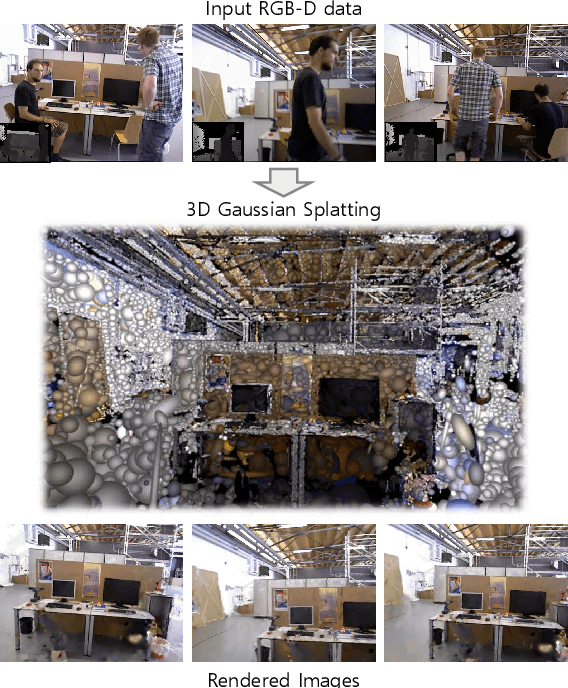
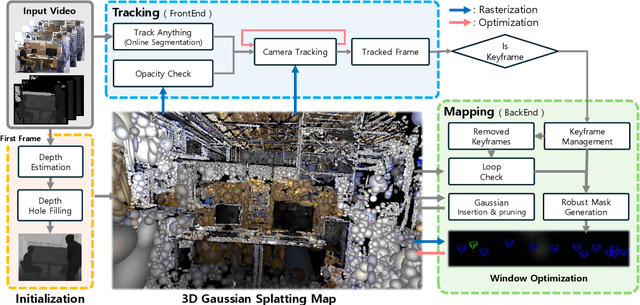
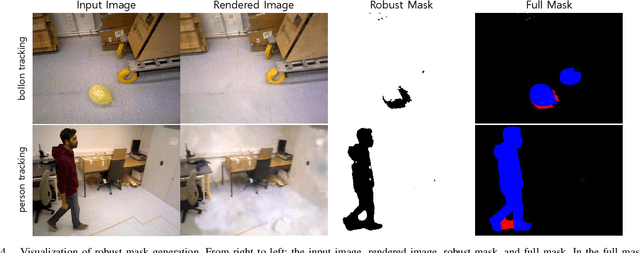

Abstract:We introduce Dynamic Gaussian Splatting SLAM (DGS-SLAM), the first dynamic SLAM framework built on the foundation of Gaussian Splatting. While recent advancements in dense SLAM have leveraged Gaussian Splatting to enhance scene representation, most approaches assume a static environment, making them vulnerable to photometric and geometric inconsistencies caused by dynamic objects. To address these challenges, we integrate Gaussian Splatting SLAM with a robust filtering process to handle dynamic objects throughout the entire pipeline, including Gaussian insertion and keyframe selection. Within this framework, to further improve the accuracy of dynamic object removal, we introduce a robust mask generation method that enforces photometric consistency across keyframes, reducing noise from inaccurate segmentation and artifacts such as shadows. Additionally, we propose the loop-aware window selection mechanism, which utilizes unique keyframe IDs of 3D Gaussians to detect loops between the current and past frames, facilitating joint optimization of the current camera poses and the Gaussian map. DGS-SLAM achieves state-of-the-art performance in both camera tracking and novel view synthesis on various dynamic SLAM benchmarks, proving its effectiveness in handling real-world dynamic scenes.
The Llama 3 Herd of Models
Jul 31, 2024Abstract:Modern artificial intelligence (AI) systems are powered by foundation models. This paper presents a new set of foundation models, called Llama 3. It is a herd of language models that natively support multilinguality, coding, reasoning, and tool usage. Our largest model is a dense Transformer with 405B parameters and a context window of up to 128K tokens. This paper presents an extensive empirical evaluation of Llama 3. We find that Llama 3 delivers comparable quality to leading language models such as GPT-4 on a plethora of tasks. We publicly release Llama 3, including pre-trained and post-trained versions of the 405B parameter language model and our Llama Guard 3 model for input and output safety. The paper also presents the results of experiments in which we integrate image, video, and speech capabilities into Llama 3 via a compositional approach. We observe this approach performs competitively with the state-of-the-art on image, video, and speech recognition tasks. The resulting models are not yet being broadly released as they are still under development.
Fast Global Localization on Neural Radiance Field
Jun 18, 2024



Abstract:Neural Radiance Fields (NeRF) presented a novel way to represent scenes, allowing for high-quality 3D reconstruction from 2D images. Following its remarkable achievements, global localization within NeRF maps is an essential task for enabling a wide range of applications. Recently, Loc-NeRF demonstrated a localization approach that combines traditional Monte Carlo Localization with NeRF, showing promising results for using NeRF as an environment map. However, despite its advancements, Loc-NeRF encounters the challenge of a time-intensive ray rendering process, which can be a significant limitation in practical applications. To address this issue, we introduce Fast Loc-NeRF, which leverages a coarse-to-fine approach to enable more efficient and accurate NeRF map-based global localization. Specifically, Fast Loc-NeRF matches rendered pixels and observed images on a multi-resolution from low to high resolution. As a result, it speeds up the costly particle update process while maintaining precise localization results. Additionally, to reject the abnormal particles, we propose particle rejection weighting, which estimates the uncertainty of particles by exploiting NeRF's characteristics and considers them in the particle weighting process. Our Fast Loc-NeRF sets new state-of-the-art localization performances on several benchmarks, convincing its accuracy and efficiency.
SUTRA: Scalable Multilingual Language Model Architecture
May 07, 2024



Abstract:In this paper, we introduce SUTRA, multilingual Large Language Model architecture capable of understanding, reasoning, and generating text in over 50 languages. SUTRA's design uniquely decouples core conceptual understanding from language-specific processing, which facilitates scalable and efficient multilingual alignment and learning. Employing a Mixture of Experts framework both in language and concept processing, SUTRA demonstrates both computational efficiency and responsiveness. Through extensive evaluations, SUTRA is demonstrated to surpass existing models like GPT-3.5, Llama2 by 20-30% on leading Massive Multitask Language Understanding (MMLU) benchmarks for multilingual tasks. SUTRA models are also online LLMs that can use knowledge from the internet to provide hallucination-free, factual and up-to-date responses while retaining their multilingual capabilities. Furthermore, we explore the broader implications of its architecture for the future of multilingual AI, highlighting its potential to democratize access to AI technology globally and to improve the equity and utility of AI in regions with predominantly non-English languages. Our findings suggest that SUTRA not only fills pivotal gaps in multilingual model capabilities but also establishes a new benchmark for operational efficiency and scalability in AI applications.
Implicit Neural Image Stitching With Enhanced and Blended Feature Reconstruction
Sep 12, 2023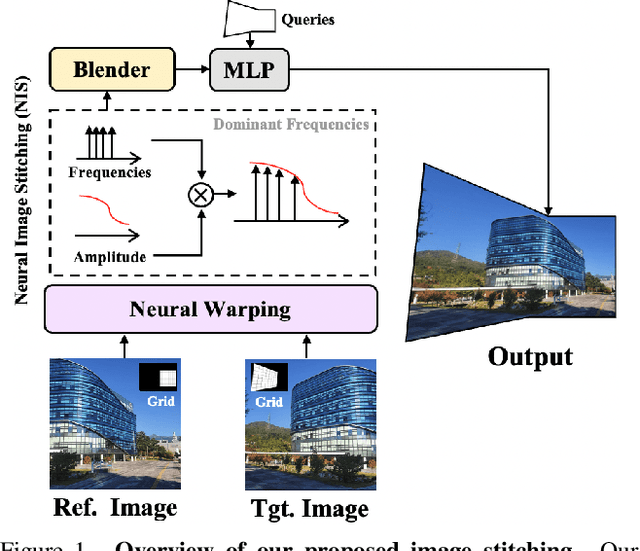
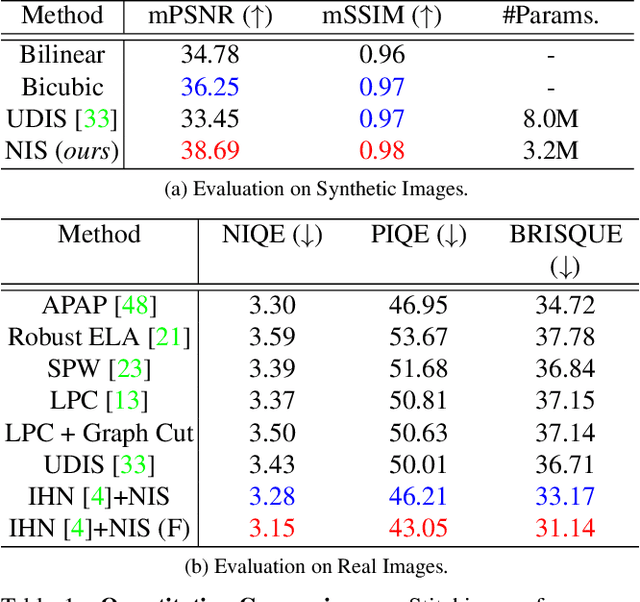

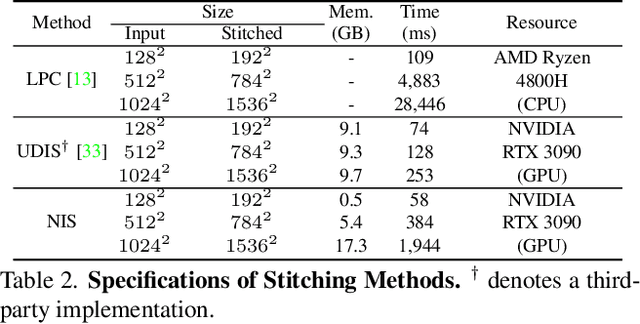
Abstract:Existing frameworks for image stitching often provide visually reasonable stitchings. However, they suffer from blurry artifacts and disparities in illumination, depth level, etc. Although the recent learning-based stitchings relax such disparities, the required methods impose sacrifice of image qualities failing to capture high-frequency details for stitched images. To address the problem, we propose a novel approach, implicit Neural Image Stitching (NIS) that extends arbitrary-scale super-resolution. Our method estimates Fourier coefficients of images for quality-enhancing warps. Then, the suggested model blends color mismatches and misalignment in the latent space and decodes the features into RGB values of stitched images. Our experiments show that our approach achieves improvement in resolving the low-definition imaging of the previous deep image stitching with favorable accelerated image-enhancing methods. Our source code is available at https://github.com/minshu-kim/NIS.
Semantic-Aware Implicit Template Learning via Part Deformation Consistency
Aug 23, 2023



Abstract:Learning implicit templates as neural fields has recently shown impressive performance in unsupervised shape correspondence. Despite the success, we observe current approaches, which solely rely on geometric information, often learn suboptimal deformation across generic object shapes, which have high structural variability. In this paper, we highlight the importance of part deformation consistency and propose a semantic-aware implicit template learning framework to enable semantically plausible deformation. By leveraging semantic prior from a self-supervised feature extractor, we suggest local conditioning with novel semantic-aware deformation code and deformation consistency regularizations regarding part deformation, global deformation, and global scaling. Our extensive experiments demonstrate the superiority of the proposed method over baselines in various tasks: keypoint transfer, part label transfer, and texture transfer. More interestingly, our framework shows a larger performance gain under more challenging settings. We also provide qualitative analyses to validate the effectiveness of semantic-aware deformation. The code is available at https://github.com/mlvlab/PDC.
Chemical Property-Guided Neural Networks for Naphtha Composition Prediction
Jun 02, 2023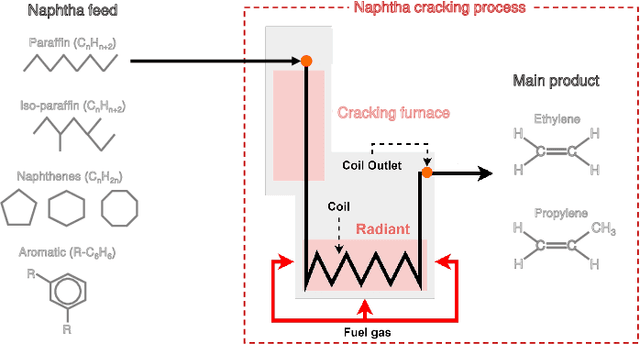
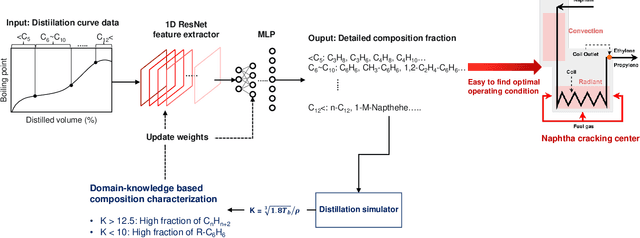
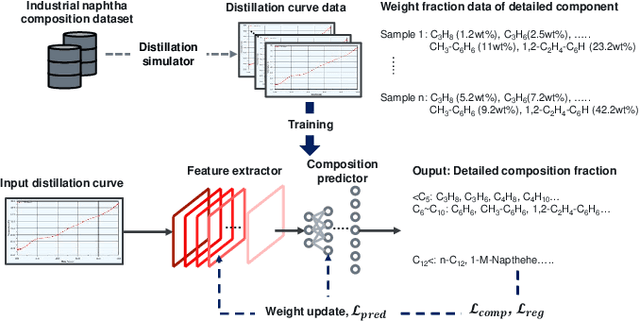

Abstract:The naphtha cracking process heavily relies on the composition of naphtha, which is a complex blend of different hydrocarbons. Predicting the naphtha composition accurately is crucial for efficiently controlling the cracking process and achieving maximum performance. Traditional methods, such as gas chromatography and true boiling curve, are not feasible due to the need for pilot-plant-scale experiments or cost constraints. In this paper, we propose a neural network framework that utilizes chemical property information to improve the performance of naphtha composition prediction. Our proposed framework comprises two parts: a Watson K factor estimation network and a naphtha composition prediction network. Both networks share a feature extraction network based on Convolutional Neural Network (CNN) architecture, while the output layers use Multi-Layer Perceptron (MLP) based networks to generate two different outputs - Watson K factor and naphtha composition. The naphtha composition is expressed in percentages, and its sum should be 100%. To enhance the naphtha composition prediction, we utilize a distillation simulator to obtain the distillation curve from the naphtha composition, which is dependent on its chemical properties. By designing a loss function between the estimated and simulated Watson K factors, we improve the performance of both Watson K estimation and naphtha composition prediction. The experimental results show that our proposed framework can predict the naphtha composition accurately while reflecting real naphtha chemical properties.
Semantic-aware Occlusion Filtering Neural Radiance Fields in the Wild
Mar 05, 2023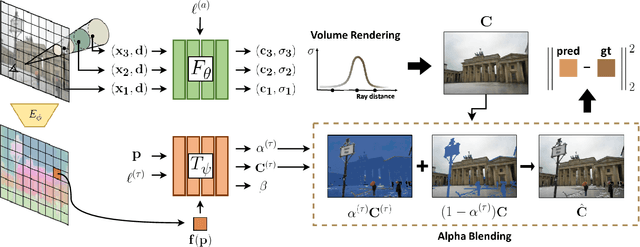
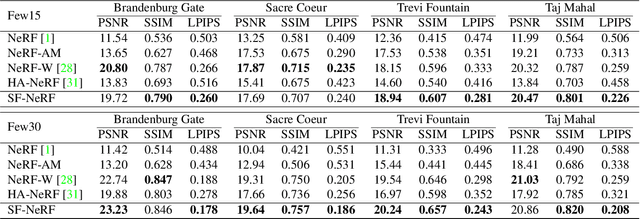
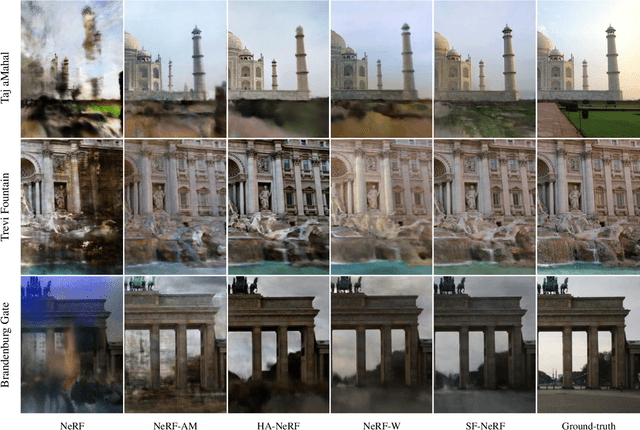

Abstract:We present a learning framework for reconstructing neural scene representations from a small number of unconstrained tourist photos. Since each image contains transient occluders, decomposing the static and transient components is necessary to construct radiance fields with such in-the-wild photographs where existing methods require a lot of training data. We introduce SF-NeRF, aiming to disentangle those two components with only a few images given, which exploits semantic information without any supervision. The proposed method contains an occlusion filtering module that predicts the transient color and its opacity for each pixel, which enables the NeRF model to solely learn the static scene representation. This filtering module learns the transient phenomena guided by pixel-wise semantic features obtained by a trainable image encoder that can be trained across multiple scenes to learn the prior of transient objects. Furthermore, we present two techniques to prevent ambiguous decomposition and noisy results of the filtering module. We demonstrate that our method outperforms state-of-the-art novel view synthesis methods on Phototourism dataset in a few-shot setting.
 Add to Chrome
Add to Chrome Add to Firefox
Add to Firefox Add to Edge
Add to Edge